Trends in MSME Digitalization in Indonesia 2023: Challenges and Opportunities
Digitalization can help and strengthen the growth of MSMEs with challenges that must be faced.
It's no secret that the Micro, Small and Medium Enterprises (MSMEs) sector plays an important role in advancing the country's economy. MSMEs have become the backbone of the country's economy because they have contributed to GDP or Gross Domestic Product and have also added employment to the community.
This can be seen from data from the Ministry of Cooperatives and Small and Medium Enterprises. Currently there are 65,4 million MSMEs in Indonesia which employ 114,7 million people or around 56% of the workforce in Indonesia. In addition, MSMEs also contribute more than 60% of the country's GDP. (MSME Empowerment Report, 2022:5).
Data from the Ministry of Cooperatives and Small and Medium Enterprises also shows that the contribution of MSMEs to GDP continued to increase before the pandemic. However, this contribution decreased to 37,3% during the pandemic. (MSME Empowerment Report, 2022:13).
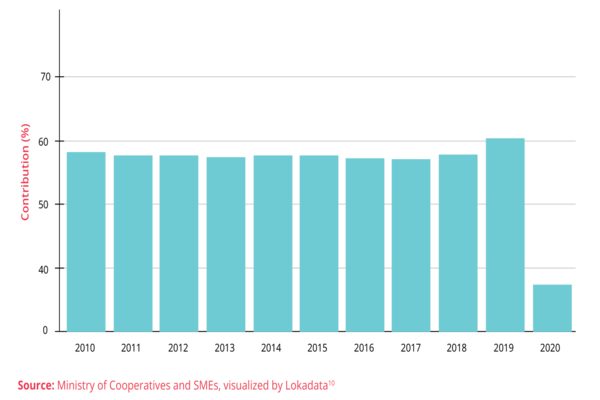
In order to survive in the midst of intense competition, especially since the pandemic, based on data from the MSME Empowerment Report (2022: 38), 83,8% of MSMEs are digitalizing or utilizing technology to support their business operations. According to the journal ofPlakoyiannaki et al. in Indriastuti and Kartika, digitalization is an opportunity for MSMEs to switch from traditional trading to new trends that apply technology.
Digitalization has caused many MSMEs to start promoting their products and services through digital platforms, both in the form of images and videos. Then, they also set up an online shop at marketplace to make it easier for customers to find their products.
Head of the Micro Business Facility Division of the Ministry of Cooperatives and SMEs, Berry Fauzi, said that many MSMEs take advantage of the network marketplace to market their products during a pandemic (MSME Empowerment Report, 2022, page 12).
"As many as 40% of MSMEs use social media, 38% use instant messaging, use E-commerce 13%, and ride hailing 5%,” said Berry.
This shows that only some MSMEs have adapted to digitalization. This is because MSME owners still encounter several obstacles in developing their business towards the digital era.
Challenges Experienced by Indonesian MSMEs
When transforming to digitalization, of course MSMEs will face several challenges. Based on a survey conducted by DSInnovate to 1.500 MSME owners, a number of obstacles were found by MSMEs.
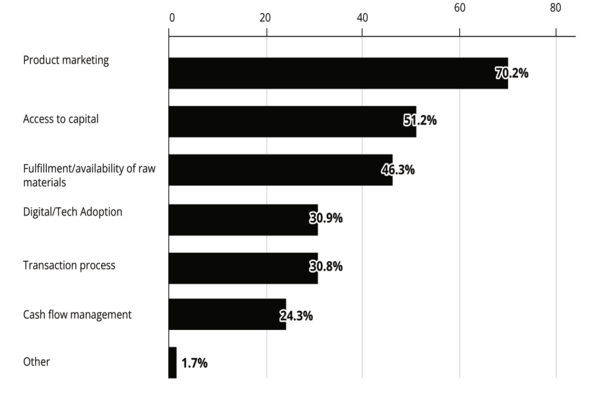
Generally, 70,2% of MSME owners have problems marketing their products. The next problem is related to access to capital (51,2%), fulfillment or supply of raw materials (46,3%), and digital adoption (30,9%).
The first challenge relates to product marketing. SMEs must build brand image strong in order to compete with others, and their financial resources are limited making it difficult for them to allocate funds for marketing activities.
The second is the financial challenge. According to the latest Bank Indonesia survey on the MSME Empowerment Report 2022, page 23), 69,5% of MSMEs have not received loans. This challenge stems from the low financial literacy of borrowers or MSMEs. At the same time, borrowers (banks and finance) also faces several challenges to meet the needs of MSMEs.
In addition, manual transactions often lack intensive record keeping, resulting in incomplete financial reports. Even though an organized bookkeeping report helps entrepreneurs to obtain more comprehensive financial services, for example to apply for People's Business Credit (KUR).
The next challenge relates to digital adoption. There are four challenges for MSMEs in digital adoption.
First, the lack of reliable digital infrastructure. According toDatabox Katadata, Indonesia dominates the population in Southeast Asia by 40,9%. Despite having a high population density, many remote or rural areas in Indonesia do not yet have access to internet connectivity.
This will make it difficult for MSMEs in this area to take advantage of digital technology, such as E-commerce and online marketing. Apart from having difficulty getting an internet connection, they also do not have reliable hardware to use digital technology, such as cell phones and laptops.
Another challenge is the lack of digital skills and knowledge among MSME owners and employees, especially in rural areas. This makes it difficult for them to utilize technology efficiently.
The next challenge is access to financial resources by borrowing business funds from banks so that MSME owners can invest in digital technology and infrastructure. International Finance Corporation reported that the lack of access to finance is a major obstacle to the digitization of MSMEs in developing countries. The data shows that around 60% of MSMEs in developing countries lack formal credit, making it difficult for them to invest in digital technology. (MSME Empowerment Report 2022, page 24)
The final digital adoption challenge is security. Every MSME needs to have the expertise or budget to implement security protocols that can protect their digital assets. Because, it was found that 44 % of cyber attacks occurred on small businesses (MSME Empowerment Report 2022, page 25).
Why Digitalization is Important for MSMEs
The presence of digitalization in MSMEs brings many opportunities for MSMEs so that they can dominate the domestic market. First, because digitalization is able to help MSMEs to increase their efficiency and productivity. By implementing digital technologies such as marketplace, digital wallets (Ovo, Gopay, etc.), as well as other digital applications for MSME players to simplify the process and save time and resources or costs required for manual tasks.
Second, digitization can help MSMEs open new markets and customers. According to a report from the Association of Indonesian Internet Service Providers (APJII) showing that internet users in Indonesia will reach more than 210 million in 2022 (MSME Empowerment Report 2022, page 52). With many internet users, MSMEs can reach a wider audience and sell their products or services outside their area.
Furthermore, digitization can make MSMEs better able to compete with large companies. From here, MSMEs can offer services and products that are on par with their larger competitors because they are helped by the tools and digital technology they use.
Finally, digitization can help MSMEs to improve financial stability and sustainability they. MSMEs can use digital tools to manage finances so as to help MSME owners better manage their cash flow and reduce the risk of economic instability.
Benefits of Digitalization for MSMEs
Digitalization brings many benefits to MSMEs in Indonesia. Based on a survey conducted by DSInnovate, there are four benefits that are most felt by MSME owners.
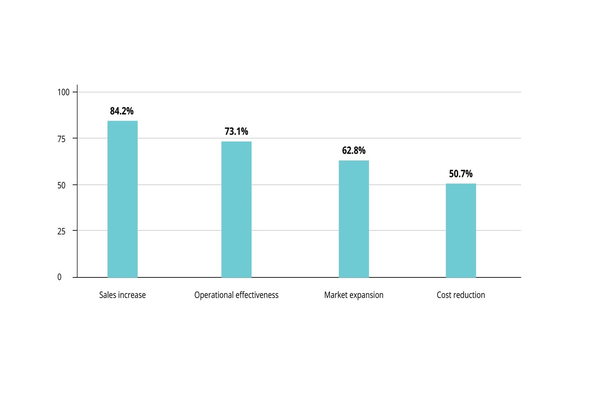
The first benefit is increased sales. The wider the marketing reach, the more people can buy the product.
Digitalization also makes it easier for MSMEs to communicate with customers and vice versa. It can also turn them into loyal customers who make repeated purchases.
Second, increase operational effectiveness. Digitization can use a lot tools and for mobile devices to report the to simplify work that does not take a lot of time and effort. For example tools CRM is very useful for facilitating the sales process and customer relationship management.
Next, market expansion. As previously mentioned, digitization allows MSMEs to reach a wider market.
If previously it could only attract local consumers, now MSMEs can attract consumers in various regions and abroad.
The final benefit is reduced operational costs. Implementing the right campaign marketing strategy can reduce operational costs. When MSMEs implement an online promotion strategy, it is much more economical than traditional promotions.
The Role of Digital Platforms for Indonesian MSMEs
The use of digital platforms provides several benefits for MSMEs. In addition to the benefits previously mentioned, MSMEs can access various data about customers and analytics that can help them make decisions.
Platform E-commerce, for example, can provide information on which products are selling well and which are not. The data can be used to make decisions about inventory management, marketing, and so on.
So, digital platforms do play an important role in increasing business productivity. This can be seen from a survey conducted by DSInnovate. The MSME Empowerment 2022 states that 99,1% of MSMEs have succeeded in increasing their business productivity after using digital services..
Still from the same survey, here are the application categories that are widely used by MSMEs to help their business operations:
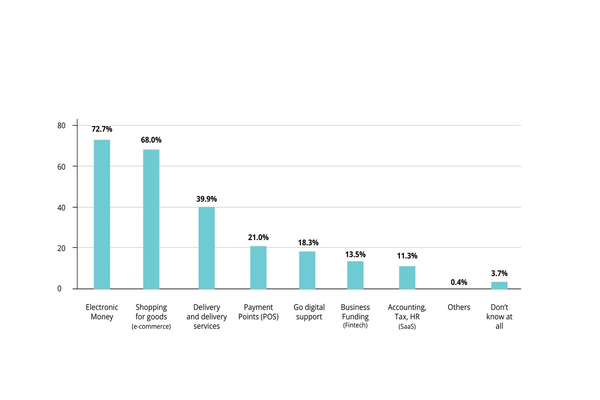
One of the digital platforms used by MSMEs is marketplace. Marketplace offers an easy and cost-effective way for MSMEs to reach a wider audience and increase their income.
With marketplace, SMEs can list their products on the market and gauge customer interest before starting large-scale production. In addition, this platform has an analytical dashboard that contains sales and customer behavior that can help MSMEs better understand their target audience.
apart marketplace, there is social commerce models, a mix of social media and E-commerce. This model offers a seamless experience by adopting the online buying and selling process as in marketplace.
According to data on the MSME Empowerment Report 2022 (page 46), app or website marketplace that have been used in the last 6 months for business purposes are Shopee (87,1%), Tokopedia (58,2%), TikTok Shop (44,8%), Bukalapak (37,8%), Blibli.com (22,6, 7,9%), other (1,2%), and do not use it (XNUMX%).
Furthermore, MSMEs also use social media because social media is part of a digital marketing tool. According to a survey conducted by We Are Social and Hootsuite, by 2021 there will be more than 132 million active social media users in Indonesia (MSME Empowerment Report (page 47). This shows a sizable opportunity for MSMEs to reach new customers.
Based on a survey conducted by DSInnovate of 1.500 MSME owners, it was found that the majority of MSMEs use social media with a focus on their goals, namely 91,3% marketing, 81,9% sales, and 72,5% interaction with customers (MSME Empowerment Report 2022, pages 49-50).
The social media platforms that are used by MSMEs for marketing, sales and interaction with customers are Instagram, Facebook, TikTok, YouTube, Twitter and LinkedIn (MSME Empowerment Report 2022, pages 49-50).
The Role of TikTok in Helping the Digitalization of Indonesian MSMEs
TikTok is a digital entertainment platform that already exists in Indonesia. Even though TikTok has social media features, the way the platform works makes it an effective digital marketing tool.
This shows that TikTok can help MSMEs in developing their businesses. According to a survey conducted by DSInnovate, 22,4% use TikTok and the TikTok Shop as sales tools (MSME Empowerment Report 2022, page 52).
There are several advantages for MSME owners who use TikTok for their business, such as increasing sales, as a promotional medium, getting new customers, and so on. Here are ten of the advantages:
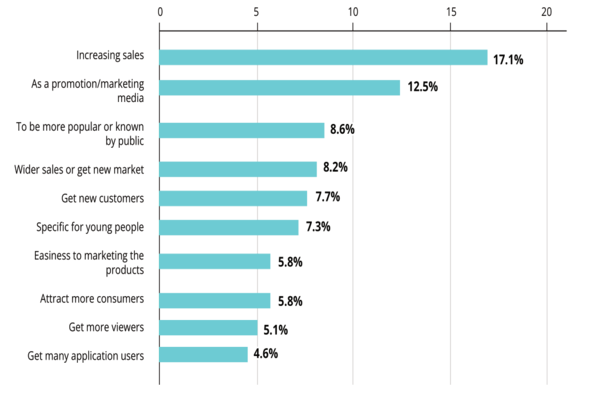
Apart from the above, the uses of TikTok for MSMEs are:
- The ability to reach new customers through creating creative short videos, such as using content challenges. Then, usage hashtags relevant content for each content can increase visibility and engagement.
- MSMEs can interact directly with the audience through live streaming with TikTok LIVE.
- The ability to market products, shop and sell directly from one application, namely TikTok Shop.
- MSMEs can see business performance, either in applications through analytical tools, or through real help through Account Managers.
TikTok Indonesia also provides several special programs for MSMEs. The first program is #MajuBarengTikTok. This program delivers workshop regarding digital marketing and the use of the TikTok application for business.
Then there is “Follow Me”, a program where MSME owners can learn from other MSME owners who have experienced success after selling on TikTok. There are also various event for MSMEs such as the TikTok Shop Summit and the TikTok Shop Seller Conference, which provide insights and opportunities networking for brand, sellers, partners, and creators.
So, now you know that digitalization can help and strengthen MSME business growth even though they still face several challenges to make it happen. If you are curious about digitizing MSMEs, download it MSME Empowerment Report 2022here.
Photo credit by Rawpixel.com on Freepik
Sign up for our
newsletter
